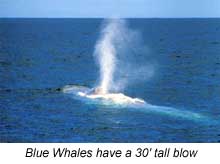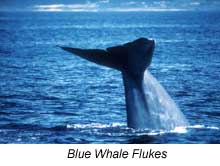
|
Monterey Bay is a prime feeding area for Blue Whales from June through
November. Blue whales occur in the Bay when krill is most abundant. Krill is
a small shrimp-like animal, or crustacean, and is the only food item consumed
by the blue whale. Several species of krill occur off California and swarm
together in large masses. Blue whales can feed on up to 4 tons of krill
every day. Central California, including Monterey Bay, is a major upwelling
region, with only 4 or 5 other intense upwelling zones in the world.
Upwelling regions are areas of extremely high productivity, resulting in
massive plankton blooms providing the base of the food chain. In addition to
blue whales, humpback whales, fin whales, minke whales, killer whales and a
variety of dolphin species feed in Monterey Bay.
|

